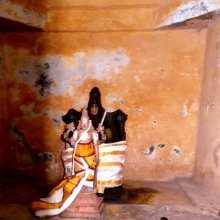Senai-mudalvar, Senai-mudaliar: 1 definition
Introduction:
Senai-mudalvar means something in Hinduism, Sanskrit. If you want to know the exact meaning, history, etymology or English translation of this term then check out the descriptions on this page. Add your comment or reference to a book if you want to contribute to this summary article.
Images (photo gallery)
In Hinduism
Shilpashastra (iconography)
Source: Shodhganga: The significance of the mūla-beras (śilpa)Senai Mudalvar is the name of a deity depicted at the Andal Temple in Srivilliputtur (Villiputtur or Thiruvilliputtur), representing a sacred place for the worship of The Goddess (Devī).—As the devotee moves a little towards the main sanctum, to the right of the devotee is the sannidhi for Senai Mudalvar. Senai Mudalvar is considered the guard of Ānṭāl. He is represented in sukhāsana posture with the right hand in abhaya-hasta and the left hand in kapittha-hasta. No weapons or accessories are held in the left hand of the Senai Mudalvar of this temple. But it can be considered that he holds a knife or axe in his left hand as he is the guard of Ānṭāl.Now, the devotee has the darśan of the mūla bera. The mūla bera is Raṅgamannar where Viṣṇu is found with Ānṭāl to his right. The Garuḍ a is found to the left of Raṅgamannar.

Shilpashastra (शिल्पशास्त्र, śilpaśāstra) represents the ancient Indian science (shastra) of creative arts (shilpa) such as sculpture, iconography and painting. Closely related to Vastushastra (architecture), they often share the same literature.
See also (Relevant definitions)
Relevant text
No search results for Senai-mudalvar, Senai-mudaliar, Senaimudalvar, Senaimudaliar; (plurals include: mudalvars, mudaliars, Senaimudalvars, Senaimudaliars) in any book or story.

